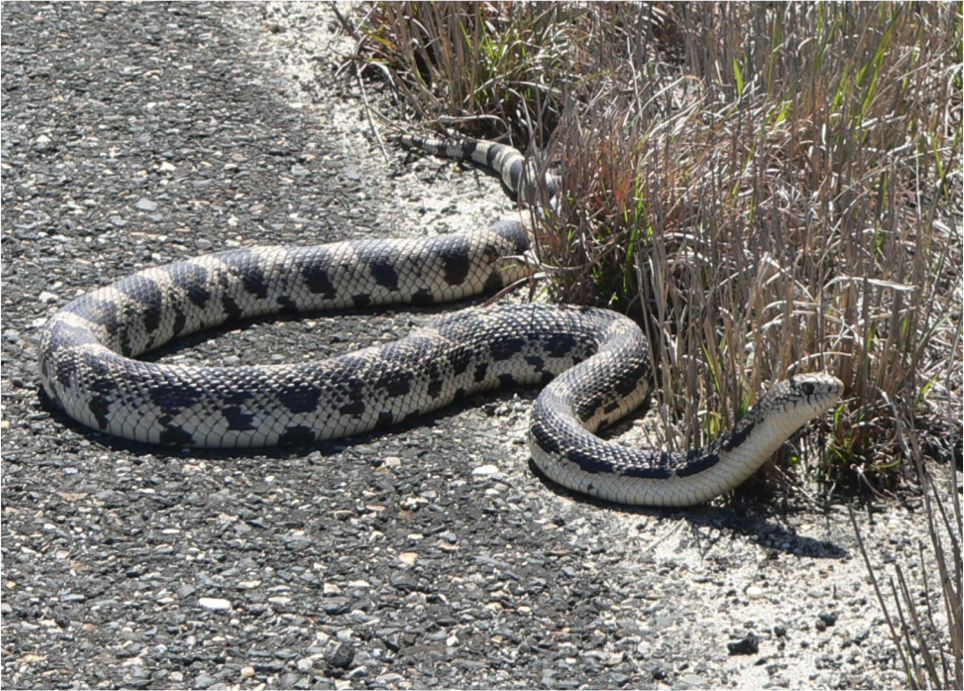Splat! Why Some Snakes Are Easy Roadkill

This story was updated at 2:45 pm ET on Aug. 22.
Concrete roads may help cars go fast, but they slow down snakes, new research finds.
A speed test for the northern pine snake (Pituophis melanoleucus) shows that it takes the snakes 2 minutes to cross a two-lane concrete road. During that time, about 70 cars may pass over a well-used highway to the New Jersey coast. On sand, a trip the same distance would last only 45 seconds, said Dane Ward, a doctoral student in environmental science at Drexel University in Philadelphia.
When a snake moves across a sandy area, it creates sandbanks that it uses to propel itself forward. Concrete does not have enough debris or grip to help with this forward motion, Ward said. "It seems that the snake is having difficulty generating enough lateral thrust to move itself farther," he told Live Science. [Watch Snakes Slither Across Roads and Sand (Video)]
To compensate, snakes on concrete roads slither in an "S" motion, which isn't typical for northern pine snakes, Ward said.
Many of the snakes, which are native to New Jersey and North Carolina, live in the protected New Jersey Pinelands National Reserve in the southern part of the state. But a network of roads throughout the reserve poses a threat to snakes when a car is nearby, which may partially explain why the snake species is threatened in New Jersey, Ward said.
Roads also threaten the snakes' habitat. The snakes grow to be about 6 feet (1.8 meters) in length and need about 1 square mile (2.6 square kilometers) in which to live, hunt and mate. But with continued development, roads are splintering the snakes' habitat in New Jersey, the most densely populated U.S. state, Ward said.
Get the world’s most fascinating discoveries delivered straight to your inbox.
To move from one natural patch to another, many snakes have to cross roads. For the past four years, Ward and his colleagues have found about 15 dead northern pine snakes every year on two popular state highways, Route 72 and County Route 539. Added to the roughly 100 snakes that die annually due to habitat loss, the snakes are in a "dire" spot, Ward said. Researchers are working hard to save the remaining 4,000 northern pine snakes living in New Jersey.
In a 2013 pilot study, researchers analyzed the benefit of a system of culverts — tubes with a soil floor that attempted to mimic the snakes' native habitat — under a newly installed runway at Warren Grove Gunnery Range. This system was designed to allow the snakes to slither beneath the roads, but few snakes ended up using the culverts, Ward said, noting that the reptiles have good spatial memory and tend to go where they've been before, perhaps avoiding the culvert system altogether.
"We have to think of ways to make these culverts a little more appealing to snakes," he said.
The northern pine snake spends much of its time underground and doesn't pose a threat to people. Like other snakes, it controls rodent populations. But, unlike snakes that use crevices, rock spaces or man-made holes for protection, the northern pine snake digs its own holes for nesting and hibernation.
"It ends up protecting a lot of other habitat for other species," Ward said.
The study was presented Aug. 15 at the 2014 Ecological Society of America annual meeting in Sacramento, California.
Editor's Note: This article has been updated to correct the location of the culvert system.
Follow Laura Geggel on Twitter @LauraGeggel and Google+. Follow Live Science @livescience, Facebook & Google+. Original article on Live Science.

Laura is the managing editor at Live Science. She also runs the archaeology section and the Life's Little Mysteries series. Her work has appeared in The New York Times, Scholastic, Popular Science and Spectrum, a site on autism research. She has won multiple awards from the Society of Professional Journalists and the Washington Newspaper Publishers Association for her reporting at a weekly newspaper near Seattle. Laura holds a bachelor's degree in English literature and psychology from Washington University in St. Louis and a master's degree in science writing from NYU.


